 W
WĀkāśagarbha Bodhisattva or Akasagarbha Bodhisattva is a bodhisattva who is associated with the great element (mahābhūta) of space (ākāśa). He is also sometimes called Gaganagañja, which means "sky-jewel."
 W
WAvalokiteśvara or Padmapani is a bodhisattva who embodies the compassion of all Buddhas. This bodhisattva is variably depicted, described and portrayed in different cultures as either male or female. In Tibet, he is known as Chenrezig. In Chinese Buddhism, Avalokiteśvara has evolved into the somewhat different female figure Guanyin, also known in Japan as Kanzeon or Kannon. In Nepal Mandal this figure is known as Jana Baha Dyah, Karunamaya, Seto Machindranath.
 W
WThe Cakrasaṃvara Tantra is an influential Buddhist Tantra. It is roughly dated to the late eight or early ninth century by David B. Gray. The full title in the Sanskrit manuscript used by Gray's translation is: Great King of Yoginī Tantras called the Śrī Cakrasaṃvara (Śrīcakrasaṃvara-nāma-mahayoginī-tantra-tāja). The text is also called the Discourse of Śrī Heruka (Śrīherukābhidhāna) and the Samvara Light (Laghusaṃvara).
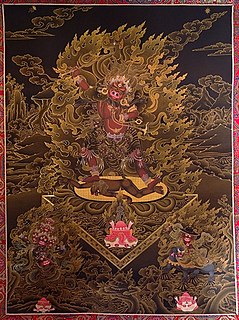 W
WEkajaṭī or Ekajaṭā,, also known as Māhacīnatārā, is one of the 21 Taras. Ekajati is, along with Palden Lhamo deity, one of the most powerful and fierce goddesses of Vajrayana Buddhist mythology. According to Tibetan legends, her right eye was pierced by the tantric master Padmasambhava so that she could much more effectively help him subjugate Tibetan demons.
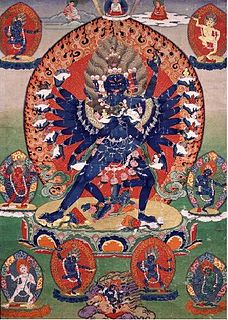 W
WHevajra is one of the main yidams in Tantric, or Vajrayana Buddhism. Hevajra's consort is Nairātmyā.
 W
WKālacakra is a polysemic term in Vajrayana Buddhism that means "wheel of time" or "time cycles". "Kālacakra" is also the name of a series of Buddhist texts and a major practice lineage in Indian Buddhism and Tibetan Buddhism. The tantra is considered to belong to the unexcelled yoga (anuttara-yoga) class.
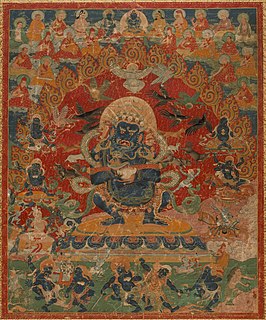 W
WMahākāla is a deity common to Hinduism, Buddhism and Sikhism. In Hinduism, Mahākāla is a manifestation of Shiva and is the consort of the goddess Mahākālī; he most prominently appears in the Kalikula sect of Shaktism. Mahākāla also appears as a protector deity known as a dharmapala in Vajrayana Buddhism, particularly most Tibetan traditions as Citipati, and in Chinese Esoteric Buddhism and in Shingon Buddhism. He is known as Dàhēitiān and Daaih'hāktīn (大黑天) in Mandarin and Cantonese, Daeheukcheon (대흑천) in Korean, Đại Hắc Thiên in Vietnamese, and Daikokuten (大黒天) in Japanese. In Sikhism, Mahākāla is referred to as Kal, who is the governor of Maya.
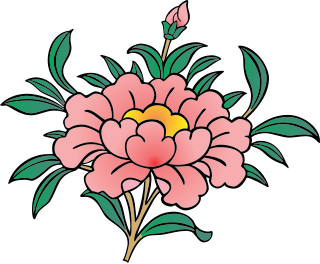 W
WThe Nīlakaṇṭha Dhāraṇī, also known as the Mahākaruṇā(-citta) Dhāraṇī, Mahākaruṇika Dhāraṇī or Great Compassion Dhāraṇī,, is a Mahayana Buddhist dhāraṇī associated with the bodhisattva Avalokiteśvara.
 W
WRakta Yamari is a Tantric Buddhist meditational deity which is a wrathful form of bodhisattva Manjushri or Yamantaka. Yamari deities have two forms: red (rakta) and black (krishna), and are part of the Anuttarayoga Class of Tantric Buddhism. The Ngor Mandala collection of the Sakya tradition alone lists eight different forms/lineages of the blue/black buffalo-faced Vajrabhairava and four of red Rakta- or blue Krishna-Yamari. All the former are yidams whereas Yamaraja is a Dharma protector.
 W
WThe Shurangama or Śūraṅgama mantra is a dhāraṇī or long mantra of Buddhist practice in China, Japan, Korea and Vietnam. Although relatively unknown in modern Tibet, there are several Śūraṅgama Mantra texts in the Tibetan Buddhist canon. It is associated with Chinese Esoteric Buddhism and Shingon Buddhism.
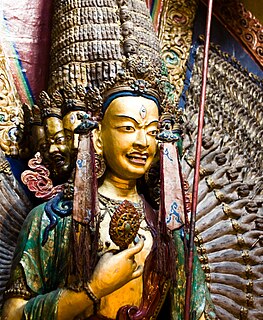 W
WSitātapatrā is a protector against supernatural danger in Buddhism. She is venerated in both the Mahayana and Vajrayana traditions. She is also known as Uṣṇīṣa Sitātapatrā. It is believed that Sitātapatrā is a powerful independent deity emanated by Gautama Buddha from his uṣṇīṣa. Whoever practices her mantra will be reborn in Amitābha's pure land of Sukhāvatī as well as gaining protection against supernatural danger and witchcraft.
 W
WThe Six Dharmas of Nāropa, are a set of advanced Tibetan Buddhist tantric practices compiled by the Indian mahasiddhas Tilopa and Nāropa and passed on to the Tibetan translator-yogi Marpa Lotsawa.
 W
WThe Buddhist Tantras are a varied group of Indian and Tibetan texts which outline unique views and practices of the Buddhist tantra religious systems.
 W
WThe Vajraśekhara Sūtra is an important Buddhist tantra used in the Vajrayāna schools of Buddhism, but can refer to a number of different works. In particular a cycle of 18 texts studied by Amoghavajra, which included both Tattvasaṃgraha Tantra, and the Guhyasamaja Tantra, a Tibetan text which appears to be composed of two works grouped together and to further confuse matters in the Japanese Shingon school the Sarvatathāgatatattvasaṃgraha Tantra is known by this name. In Tibetan it is considered to be the main representative of the Yogatantra class of texts.
 W
WA Yamari is a yidam or meditation deity of the Anuttara Yoga Tantra method (father) classification. The Word यमारि yamāri in Sanskrit means Yama's Enemy There are three types of Yamari:Krishna Yamari Rakta Yamari Yamantaka sometimes referred to as Vajrabhairava